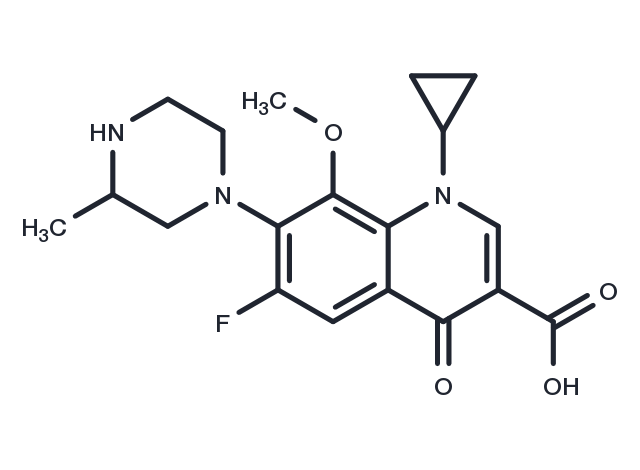Powder: -20°C for 3 years | In solvent: -80°C for 1 year


Gatifloxacin (CG5501) is an antibiotic of the fourth-generation fluoroquinolone family, that like other members of that family, inhibits the bacterial enzymes DNA gyrase and topoisomerase IV.

| Pack Size | Availability | Price/USD | Quantity |
|---|---|---|---|
| 500 mg | In stock | $ 41.00 | |
| 1 g | In stock | $ 48.00 |


| Description | Gatifloxacin (CG5501) is an antibiotic of the fourth-generation fluoroquinolone family, that like other members of that family, inhibits the bacterial enzymes DNA gyrase and topoisomerase IV. |
| Targets&IC50 | Topo II:36.7 μM (IC50) |
| In vitro | Gatifloxacin increases serum adrenaline levels in both normal and diabetic rats, and concurrently reduces serum glucose concentrations in these subjects. |
| In vivo | Gatifloxacin exhibits potent inhibitory activity against bacterial type II topoisomerases, with half-maximal inhibitory concentrations (IC50) of 13.8 mg/mL and 0.109 mg/mL for Staphylococcus aureus topoisomerase and Escherichia coli DNA gyrase, respectively. Its inhibitory effect on HeLa cell topoisomerase II is minimal, with an IC50 of 265 mg/mL. Gatifloxacin inhibits Mycobacterium tuberculosis ATCC 35801 with a minimum inhibitory concentration (MIC) of 0.125 μg/mL. When used in combination with ciprofloxacin, gatifloxacin demonstrates a synergistic effect on 19% of 31 strains of Pseudomonas aeruginosa. However, gatifloxacin's activity is two-fold lower than that of ciprofloxacin and two-fold less potent than ofloxacin against Enterobacteriaceae. Gatifloxacin shows strong antimicrobial activity against Haemophilus influenzae, Legionella, and Helicobacter pylori (MIC90s, 0.03-0.06 mg/L), and at least an eight-fold greater efficacy against Chlamydiaceae and Mycoplasmataceae (gatifloxacin MIC90s, 0.13 mg/L). |
| Synonyms | BMS 206584-01, PD 135432, CG5501, BMS-206584, AM-1155 |
| Molecular Weight | 375.39 |
| Formula | C19H22FN3O4 |
| CAS No. | 112811-59-3 |
Powder: -20°C for 3 years | In solvent: -80°C for 1 year
DMSO: 3.8 mg/mL (10 mM), Heating is recommended.
You can also refer to dose conversion for different animals. More
bottom
Please see Inhibitor Handling Instructions for more frequently ask questions. Topics include: how to prepare stock solutions, how to store products, and cautions on cell-based assays & animal experiments, etc.
Gatifloxacin 112811-59-3 DNA Damage/DNA Repair Microbiology/Virology Topoisomerase Antibacterial Antibiotic Inhibitor S. aureus BMS 206584-01 E. coli,?Pseudomonas aeruginosa,?Micrococcus luteus hyperglycemia N. brasiliensis conjunctivitis AM1155 CG-5501 PD 135432 Bacterial PD-135432 BMS206584 inhibit CG5501 diabetic hypoglycemia AM 1155 BMS-206584 AM-1155 PD135432 actinomycetoma BMS 206584 CG 5501 inhibitor
